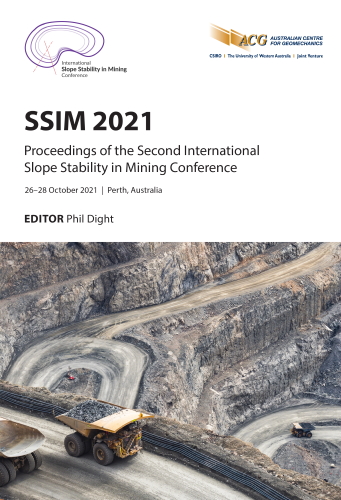Preliminary identification of persistent or pervasive discontinuities from borehole data

|
Authors: Whittall, J; Danielson, J |
DOI https://doi.org/10.36487/ACG_repo/2135_07
Cite As:
Whittall, J & Danielson, J 2021, 'Preliminary identification of persistent or pervasive discontinuities from borehole data', in PM Dight (ed.), SSIM 2021: Second International Slope Stability in Mining, Australian Centre for Geomechanics, Perth, pp. 149-158, https://doi.org/10.36487/ACG_repo/2135_07
Abstract:
Open pit slope designs are often controlled by persistent or pervasive discontinuities in a rock mass. Whether a discontinuity will be important for inter-ramp and overall scale assessments is difficult to ascertain, especially for development projects without exposed outcrops. Such assessments often rely on observations from individual boreholes grouped on stereonets without consideration of how discontinuities might link between boreholes. This paper provides a preliminary methodology to identify persistent or pervasive discontinuity sets from boreholes with televiewer or oriented core data. If at least three boreholes are drilled proximal to each other, a plane can be fit through discontinuities from each borehole. The pole vector from each measured discontinuity can be compared with each other, and to the fitted plane, to connect similarly oriented discontinuities across the boreholes. The angular distance between the mean of the measured pole vectors and the fit plane pole vector can be filtered to remove poorly matched discontinuities, leaving a set of discontinuities that are either persistent across the boreholes or sufficiently pervasive that non-persistent planes link up (e.g. bedding planes). The methodology can be extended to any georeferenced discontinuity orientation data to connect borehole and mapping measurements. This may be useful to connect mapped discontinuities across benches, identify through-going structures and improve persistence estimates. The approach is useful for set ranking, interrogation of structural domain boundaries, and preliminary justifications for some degree of rock bridging. Discontinuity orientations that do not intersect at least three boreholes cannot be assessed with this methodology, especially if the boreholes are widely spaced, short, or have large differences in collar elevations. This paper illustrates the methods and potential applications of this approach using a demonstrated example from three boreholes through a pit wall with photogrammetry data.
Keywords: persistence, set ranking, borehole data, censoring bias
References:
Brown, ET 2003, Block Caving Geomechanics, 3rd edn, Julius Kruttschnitt Mineral Research Centre, University of Queensland Press, Brisbane.
Brueckman, C 2016, Reliability Analysis of Discrete Fracture Network Projections from Borehole to Shaft Scale Discontinuity Data, Masters thesis, University of British Columbia, Vancouver.
Cruden, DM 1977, ‘Describing the size of discontinuities’, International Journal of Rock Mechanics and Mining Sciences, vol. 14, pp. 133–137,
Mathis, JI 2020, 'Capturing/interpreting non-obvious slope controlling structures', in PM Dight (ed.), Slope Stability 2020: Proceedings of the 2020 International Symposium on Slope Stability in Open Pit Mining and Civil Engineering, Australian Centre for Geomechanics, Perth, pp. 499–506,
Priest, SD 1993, Discontinuity Analysis for Rock Engineering, Chapman & Hall, London.
Sturzenegger, M 2010, Multi-scale Characterization of Rock Mass Discontinuities and Rock Slope Geometry Using Terrestrial Remote Sensing Techniques, PhD thesis, Simon Fraser University, Burnaby.
Tuckey, Z, Stead, D, Havaej, M, Gao, F & Sturzenegger, M 2012, Towards an integrated field mapping-numerical modelling approach for characterising discontinuity persistence and intact rock bridges in large open pits’, The Canadian Geotechnical Society (Geo Manitoba), Winnipeg.
Vollmer, FW 1995, ‘C program for automatic contouring of spherical orientation data using a modified Kamb method’, Computers & Geosciences, vol. 21, issue 1, pp. 31–49.
© Copyright 2024, Australian Centre for Geomechanics (ACG), The University of Western Australia. All rights reserved.
View copyright/legal information
Please direct any queries or error reports to repository-acg@uwa.edu.au
View copyright/legal information
Please direct any queries or error reports to repository-acg@uwa.edu.au